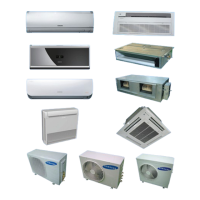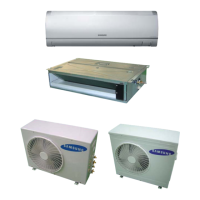What to do if the Timer LED is on but my Samsung MH020FWEA Air Conditioner won't turn on?
- Aamanda03Aug 13, 2025
The timer is activated, and the unit is in ready mode. Cancel the timer operation for normal operation.

What to do if the Timer LED is on but my Samsung MH020FWEA Air Conditioner won't turn on?
The timer is activated, and the unit is in ready mode. Cancel the timer operation for normal operation.
Why doesn't my Samsung MH020FWEA Air Conditioner cool when the room is hotter than the set temperature?
This can happen after a 3-minute delay when the compressor is re-operated, or when power is turned on.
What to do if my Samsung MH020FWEA's compressor stops intermittently in COOL or DRY mode, and the fan speed decreases?
The compressor might be stopping intermittently, or the indoor fan speed might be decreasing, to prevent the inside/outside air from freezing, depending on the inside/outside air temperature.
Why does my Samsung Air Conditioner's compressor stop intermittently in DRY mode?
In DRY mode, the compressor operation is automatically controlled depending on the room temperature and humidity.
Why does the compressor and indoor fan stop intermittently in HEAT mode on my Samsung Air Conditioner?
To protect the compressor from overheated air in HEAT mode, the compressor and indoor fan will stop intermittently if the room temperature exceeds the set temperature.
Why do the indoor and outdoor fans stop intermittently in HEAT mode on my Samsung MH020FWEA?
In HEAT mode, the compressor operates in a reverse cycle to remove exterior ice. The indoor and outdoor fans do not operate intermittently for within 20% of the total heater operation.
Why is the compressor of the outdoor unit operating when my Samsung MH020FWEA Air Conditioner is turned off in HEAT mode?
When the unit is turned off while de-ice is activated, the compressor continues operation for up to 12 minutes (maximum) until the deice is completed.
What to do if my Samsung MH020FWEA Air Conditioner indoor and outdoor units do not operate properly?
Check the terminals to ensure the indoor and outdoor units are properly linked by the same number of cables and that the connecting position on the terminal is correct.
| Brand | Samsung |
|---|---|
| Model | MH020FWEA |
| Category | Air Conditioner |
| Language | English |
Guidelines for proper indoor unit installation to ensure safety and performance.
Electrical safety precautions for power supply and circuit breaker connections.
Safe operating procedures and precautions to avoid issues during use.
Environmental guidelines for proper disposal of the air conditioner unit.
General safety precautions and standards related to the product's use.
Overview of key features and benefits of the Multi Inverter series.
Detailed technical specifications for various indoor unit models.
Comparison of specifications across different indoor and outdoor unit models.
Lists accessories and their part numbers for indoor and outdoor units.
Lists error codes and their corresponding checks for troubleshooting indoor and outdoor units.
Procedure for setting various operational options via the remote control.
Lists required tools for disassembly and reassembly procedures.
Procedures for the disassembly and reassembly of various outdoor unit models.
Detailed breakdown and part list for various indoor unit components.
Detailed breakdown and part list for various outdoor unit components.
Wiring diagrams for indoor unit connections and components.
Wiring diagrams for various outdoor unit models.
Schematic diagrams for indoor unit circuitry.
Schematic diagrams for various outdoor unit models.
Diagram of the main PCB for indoor units, showing component locations.
Diagram of the main PCB for outdoor units, showing component locations.
Initial checks and common issues before detailed troubleshooting.
Procedures for checking installation and performing operational tests.
Systematic troubleshooting based on observed symptoms and error codes.
Guidelines and procedures for inspecting and repairing printed circuit boards.
Diagnostic steps for major components like sensors and motors.
Guidelines for choosing the optimal installation location for indoor and outdoor units.
Steps for connecting refrigerant lines and purging the system.
Procedure for refilling refrigerant after leaks or installation.
Guidelines for adjusting refrigerant based on pipe length and conditions.
Specifies torque values for flare nut connections to ensure proper sealing.
Method for safely recovering refrigerant before servicing or moving the unit.
Explanation of model naming conventions and component codes.
Visual representation of the refrigerant flow and components in the system.
Data on pressure and capacity conversion for different units.
Glossary of technical terms and abbreviations used in the manual.
Frequently asked questions and answers for common non-trouble issues.
Basic principles and understanding of refrigeration systems.












